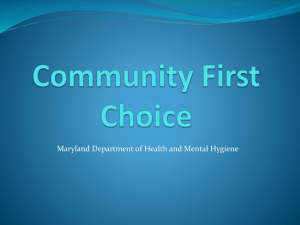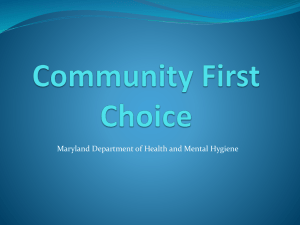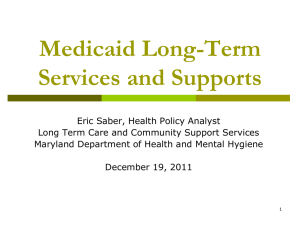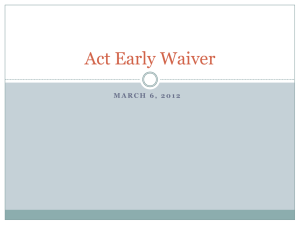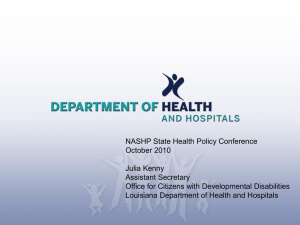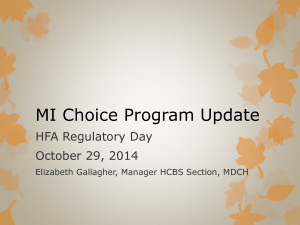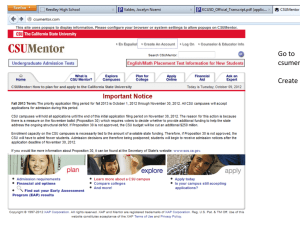Community First Choice
advertisement
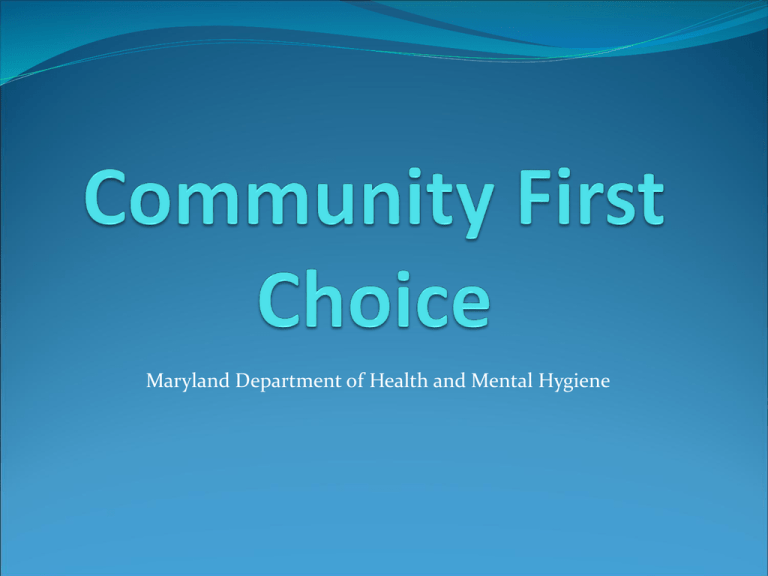
Maryland Department of Health and Mental Hygiene Community First Choice (CFC) Affordable Care Act (ACA) program expanding options for community-based long-term services and supports. Allows waiver-like services to be provided in the State Plan Emphasizes self direction Increases the State’s enhanced match on all CFC services by 6 % Allows Medicaid to set consistent policy and rates across programs Requires an institutional level of care CFC will offer all mandatory and optional services allowable Personal assistance services Emergency back-up systems Transition services, Items that substitute for human assistance Technology, accessibility adaptations, home delivered meals, etc. 2 Old Service Structure Maryland operated 3 Medicaid programs that offered personal assistance services: Medical Assistance Personal Care (MAPC) State plan program that offers personal care and nurse case monitoring Uses the 302 assessment and has a 1 ADL medical necessity standard Living at Home (LAH) Waiver Target group ages 18-64 with disabilities Nursing Facility Level of Care standard Waiver for Older Adults (WOA) Target group aged 50 and over Nursing Facility Level of Care standard 3 New Service Structure Services formerly offered through multiple programs are now consolidated under CFC Maximizes the enhanced Federal match Resolves inconsistent rates and policies across programs These two 1915(c) waiver programs merged into a single waiver Reduces duplicate applications Offers a full menu of services to waiver participants Simplifies administration 4 Service and System Enhancements CFC adds emphasis on person-centered planning and self- direction Maryland Department of Disabilities (MDOD) will be providing self-direction training on hiring, firing, and managing providers CFC offers the participant some flexibility in choosing provider rates for personal assistance services Budgets will be set based on the assessment of need and approved by the Department Participants will be able to act as their own supports planner and request changes to their plans and rates via the LTSSMaryland tracking system portal 5 Enhancements for Participants • All participants have access to: increased self-direction opportunities, a larger provider pool, and choice of supports planning providers Waiver participants now have choice in case management (supports planning) providers and access to a larger provider pool MAPC will move to an improved rate structure and increased self direction options More people in the community will have access to waiver-like services 6 Levels of Care The new merged waiver will continue to use the nursing facility level of care The CFC program will be available to individuals who meet any institutional level of care. Includes nursing facility, chronic hospitals, ICF/IID, and psychiatric hospitals MAPC uses a standard that is lower than NF LOC; one ADL We estimate that approximately 80% of the MAPC participants meet nursing facility LOC and will be eligible to receive CFC services MAPC and NF Levels of Care will be determined with a core standardized assessment instrument, the interRAI-Home Care, completed by local health department clinicians Levels of care will be reviewed annually 7 New Service Structure MAPC Personal Assistance Services Case Management/Supports Planning Nurse Monitoring Personal Emergency Back-up Systems Transition Services Consumer Training Home Delivered Meals1 Assistive Technology1 Accessibility Adaptations1 Environmental Assessments Medical Day Care Nutritionist/Dietician Family Training Behavioral Consultation Assisted Living Senior Center Plus 1. Items that sub *CFC Services will be available to all waiver participants CFC CO Waiver Financial Eligibility Participants must already be in a waiver and meet the financial qualifications of that waiver, OR Participants must be eligible for Medicaid under the State Plan AND Participants must Be in an eligibility group under the State plan that includes nursing facility services; or If in an eligibility group under the State plan that does not include such nursing facility services, have an income that is at or below 150 percent of the Federal poverty level (FPL) 10 Medical Eligibility The individual must meet the institutional level of care Individuals participating in any of the waiver programs meet an institutional level of care, as this is a requirement for all waivers Community Options, New Directions, Community Pathways, Autism, Brain Injury, Medical Day Care, Model Medical needs will be assessed by the Local Health Department using the interRAI UCA (currently Delmarva) will verify Nursing Facility and MAPC levels of Care 11 Participation in Other Programs Waiver participants are eligible to receive CFC services, but supports should be coordinated between programs to ensure adequate supports without duplication of services or allowing contraindicated services Participants who receive bundled payments for some DDA, assisted living, or PACE services are not eligible to receive CFC services on the same day Supports planners must obtain copies of supports plans from other programs, upload them into the LTSS, and account for them in the LTSS POS 12 Community Definition To be eligible for CFC, the participant must reside in a community residence as defined by the new Federal regulation CMS Toolkit on the community definition released on March 2014 Important eligibility requirement that means that the participant has: access to the community and community services, control over choice of roommates, choice of if and when to receive visitors, access to food at any time, landlord-tenant or real property laws of the jurisdiction, and privacy and locks. 13 Community Definition People in assisted living, group homes, and alternative living units are not currently eligible for CFC Definition will apply to most HCBS settings in the future Unknown impact on day settings Rebecca VanAmburg is the State lead on implementation Have until March 2015 to develop a transition plan for all programs to meet the definition Up to 5 years to implement the plan, if approved by CMS Will be hosting stakeholder groups and gathering public input on a transition plan CFC Budget Process Community First Choice Process Eligible for Medicaid (through a waiver or state plan) Assigned a personal budget Develops Plan of Service Assessed by Local Health Department Department (DHMH) approves Plan of Service Applicant selects Supports Planner Participant begins receiving services 16 How budget is determined The interRAI assessment has existing algorithms statistically validated in this instrument to assign one of 23 Resource Utilization Groups (RUGs) to participants Using RUGs-based acuity, the Department assigns participants to groups with a given budget for each group based on a scale of needs Participants will use this budget for certain services and are then empowered to determine their personal assistance hours and schedules within their budget Other services will be provided as needed and accounted for outside of the flexible budget 17 Budgets by Group Grouper Description Group 1 Physical Function – Low ADL Budget $8,336 Group 2 Behavioral – Low ADL, High IADL $16,167 Group 3 Clin. Complex – Low to Medium ADL $22,504 Group 4 Physical Function – High ADL $30,314 Group 5 Extensive Services 1 – Medium to High ADL $34,545 Group 6 Extensive Services 2 – Medium to High ADL $43,558 Group 7 Extensive Services 3 – Medium to High ADL $76,360 18 Services within the flexible budget 1. 2. 3. Personal Assistance Home-Delivered Meals “Other” Items that Substitute for Human Assistance All other services are included in the Plan of Service in addition to the flexible budget 19 Services in the Plan CFC Services Allowable Under Flexible Budget Other CFC Services based on the Individual Participant’s Assessed Needs Personal Assistance Technology Dietitian and Nutrition Services Home-Delivered Meals Environmental Accessibility Adaptations Family Training Other items that Substitute for Human Assistance Environmental Assessments Medical Day Care Supports Planning Behavioral Health Consultation Transition Services Senior Center Plus Consumer Training Personal Emergency Response Systems Waiver Services Assisted Living Nurse Monitoring 20 Example--Participants receiving personal assistance services 7 days a week Group 1 Group 2 Group 3 Group 4 Group 5 Group 6 Group 7 Annual Budget $ 8,336 $ 16,167 $ 22,504 $ 30,314 $ 34,545 $ 43,558 $ 76,360 Hours at Min Hours at Max Hours at Hours at independent independent standard standard rate rate rate agency rate Daily Budget ($10.22) ($14.27) ($12.27) ($16.08) 1.6 2.2 1.9 1.4 $22.84 3.1 4.3 3.6 2.8 $44.29 4.3 6.0 5.0 3.8 $61.65 5.8 8.1 6.8 5.2 $83.05 6.6 9.3 7.7 5.9 $94.64 8.4 11.7 9.7 7.4 $119.34 14.7 20.5 17.1 13.0 $209.21 21 Exception Process If a person cannot be supported in the community within the recommended flexible budget, an exceptions process exists to request additional funds, beyond those assigned through the interRAI and the RUGs referenced. The exceptions process is also used to request items of services not recommended by the clinician in the recommended plan of care The supports planner is responsible for explaining this process to the participant, completing the exceptions form, acquiring any additional documentation needed to support the exception request, and uploading all supporting documents to the LTSSMaryland tracking system 22 Concerns about implementation Adequate, accurate information about denials and appeal rights Process of negotiating exceptions requests before approval Requests for additional information about process and outcomes How many people negotiated hours to avoid denials? How many people have had their hours cut? Has anyone gone back to a facility because of a reduction? How is DHMH processing exceptions? What are the criteria for approval? What are the qualifications of the supports planners and review team at DHMH? 23 DHMH is committed to addressing all concerns and offering transparency 94% of plans with exceptions are approved 1% denial rate overall for the nearly 3,000 plans approved to date Public meeting, led by advocates, to be held June 16th so all concerns and issues can be heard by DHMH Data requests in progress Number of people reinstitutionalized Number of people who have experienced a reduction in hours Spending on personal assistance services pre-and post implementation 24 Other Upcoming Change Fair Labor Standards Act Domestic Service Final Rule FLSA Domestic Service Final Rule 29 CFR 552 Published October 1, 2013, with an effective date of January 1, 2015. Regulations concern domestic workers under the FLSA, bringing minimum wage and overtime protection to workers who enable individuals with disabilities and the elderly to continue to live in their homes and participate in their communities. Co-employers DOL definition: An employer of a personal assistance provider other than the individual receiving services or their representative Maryland is likely to be considered the co-employer Based on DOL’s example of Oregon’s program Co-employers cannot claim exemptions of minimum wage and overtime Overtime When the State is the co-employer, overtime applies across participants Current 40 hour per week limit is per participant If a provider works for John and Jane, they can work 40 hours for John and 40 hours for Jane (total of 80 hours) New limit is for the provider Expands to include all participants the provider serves The provider can only work 40 hours total for both John and Jane Travel time Existing regulations state that employees who travel to more than one worksite for an employer during the workday must be paid for travel time between each worksite Once the state I the co-employer, the provider will get paid for travel time between participant Time between shifts for John and Jane Next Steps Further Research How are other States implementing the rule? How many of our providers serve more than 1 person per day? How many providers work more than 40 hours because they work for more than 1 participant? What is the budget impact? How do you calculate travel time? What budget pays for the travel time? Future Stakeholder Meetings and Discussion Questions? Lorraine Nawara Lorraine.nawara@maryland.gov Referrals/General Questions DHMH.CFC@maryland.gov 410-767-1739 31
